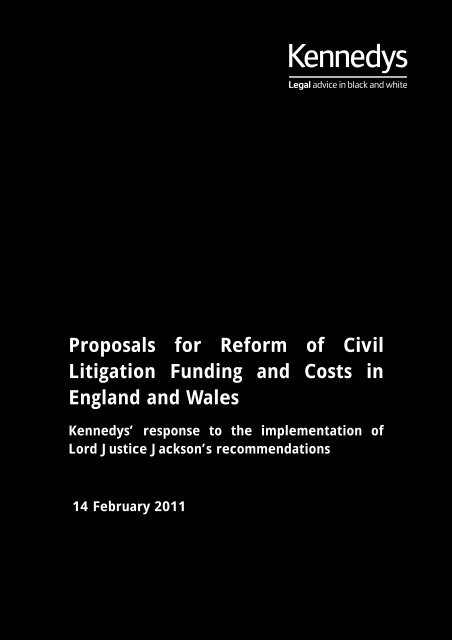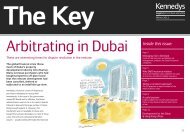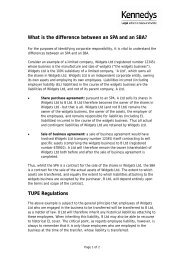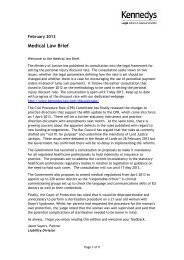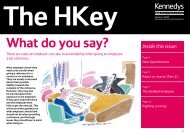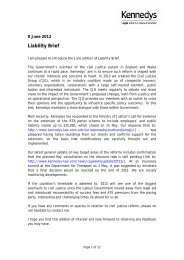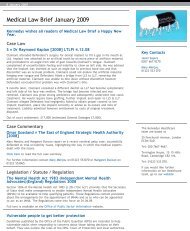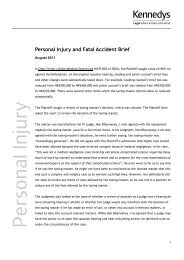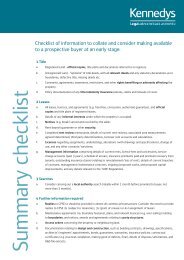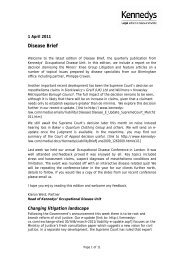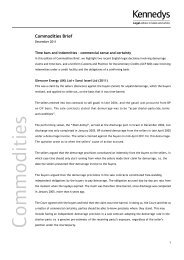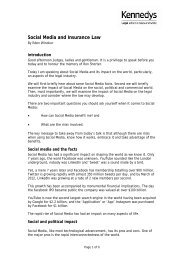Proposals for Reform of Civil Litigation Funding and ... - Kennedys
Proposals for Reform of Civil Litigation Funding and ... - Kennedys
Proposals for Reform of Civil Litigation Funding and ... - Kennedys
You also want an ePaper? Increase the reach of your titles
YUMPU automatically turns print PDFs into web optimized ePapers that Google loves.
<strong>Proposals</strong> <strong>for</strong> Re<strong>for</strong>m <strong>of</strong> <strong>Civil</strong><br />
<strong>Litigation</strong> <strong>Funding</strong> <strong>and</strong> Costs in<br />
Engl<strong>and</strong> <strong>and</strong> Wales<br />
<strong>Kennedys</strong>’ response to the implementation <strong>of</strong><br />
Lord Justice Jackson’s recommendations<br />
14 February 2011
Table <strong>of</strong> contents<br />
LEGAL ADVICE IN BLACK AND WHITE .........................................................1<br />
PREAMBLE.........................................................................................2<br />
SECTION 2.1 - CONDITIONAL FEE AGREEMENTS AND SUCCESS FEES .....................7<br />
SECTION 2.2 - AFTER THE EVENT INSURANCE PREMIUMS................................ 14<br />
SECTION 2.3 - 10% INCREASE IN GENERAL DAMAGES ..................................... 19<br />
SECTION 2.4 – PART 36 OFFERS ............................................................. 22<br />
SECTION 2.5 – QUALIFIED ONE WAY COSTS SHIFTING (QOCS) .......................... 25<br />
SECTION 2.7 – ALTERNATIVE RECOMMENDATIONS ON RECOVERABILITY .............. 29<br />
SECTION 2.8 – PROPORTIONALITY........................................................... 30<br />
SECTION 2.9 – DAMAGES-BASED AGREEMENTS (DBAS) ................................... 33<br />
APPENDIX 1A ................................................................................... 36<br />
APPENDIX 1B ................................................................................... 37<br />
APPENDIX 2 ..................................................................................... 39
Legal advice in black <strong>and</strong> white<br />
“The firm is one <strong>of</strong> the largest <strong>and</strong> strongest dispute resolution practices in<br />
the country' <strong>and</strong> 'has a deep underst<strong>and</strong>ing <strong>of</strong> the pressures <strong>of</strong> the client's<br />
bottom-line <strong>and</strong> has developed a reputation <strong>for</strong> providing straight<strong>for</strong>ward,<br />
pragmatic advice cost effectively.”<br />
Chambers <strong>and</strong> Partners<br />
<strong>Kennedys</strong> is a top 50 specialist national <strong>and</strong> international legal firm with unrivalled<br />
expertise in litigation <strong>and</strong> dispute resolution. We have over 800 people globally<br />
across nine UK <strong>and</strong> eight international locations.<br />
Our lawyers provide a range <strong>of</strong> specialist legal services across many areas such as:<br />
insurance/reinsurance, general liability, including motor, personal injury,<br />
employers’ <strong>and</strong> public liability <strong>and</strong> product liability, as well as property <strong>and</strong><br />
construction, pr<strong>of</strong>essional indemnity, healthcare, life <strong>and</strong> health, occupational<br />
disease, employment <strong>and</strong> health, safety <strong>and</strong> environment.<br />
We h<strong>and</strong>le a wide range <strong>of</strong> insurance disputes <strong>and</strong> litigation with a client base that<br />
includes general insurers, global composites, Lloyd's syndicates, underwriters, selfinsured<br />
PLCs <strong>and</strong> self-insuring government bodies.<br />
The firm has exp<strong>and</strong>ed considerably over the last eight years, largely as a result <strong>of</strong><br />
organic growth but also by selected lateral hires made to strengthen key areas <strong>of</strong><br />
expertise. Today, <strong>Kennedys</strong> is well equipped with a regional network that can<br />
provide our specialist services throughout the UK. <strong>Kennedys</strong>' global <strong>and</strong> national<br />
network enables us to meet the current <strong>and</strong> future needs <strong>of</strong> our clients, the<br />
insurance market <strong>and</strong> the aspirations <strong>of</strong> our people.<br />
Page 1 <strong>of</strong> 39
Preamble<br />
As practitioners <strong>and</strong> on behalf <strong>of</strong> our clients, we have real concerns about<br />
disproportionate costs in our <strong>Civil</strong> <strong>Litigation</strong> system. These excessive costs have, in<br />
our view, been largely caused by the recoverability <strong>of</strong> success fees <strong>and</strong> ATE<br />
insurance premiums. Given that costs are so high <strong>and</strong> frequently outstrip damages<br />
by a significant margin, they have come to be at the <strong>for</strong>efront <strong>of</strong> decision-making<br />
in litigation, which must be to the detriment <strong>of</strong> fairness <strong>and</strong> access to justice<br />
considerations. We do not believe the present system <strong>of</strong> recoverability <strong>of</strong><br />
additional liabilities is a sustainable system.<br />
We also believe the emergence <strong>of</strong> CFAs <strong>and</strong> recoverability has harmed longst<strong>and</strong>ing<br />
principles in relation to costs that have held sway <strong>for</strong> two hundred years.<br />
By that we mean principles such as inter-party costs being awarded as an<br />
indemnity 1 , as opposed to being awarded on the basis <strong>of</strong> punishment or bonus (as<br />
now occurs). Such principles were important <strong>and</strong> ensured a proportionate cost<br />
liability was placed upon a losing party. We would go so far as to say that the<br />
present costs regime can operate as an oppressive burden upon a party brought<br />
into litigation, thereby preventing access to justice.<br />
Claimant lawyers will no doubt refer to the principle <strong>of</strong> "full compensation".<br />
However, such a concept is relatively new <strong>and</strong> does not justify the retention <strong>of</strong> a<br />
costs regime at disproportionate cost to society at large. Indeed Sir Rupert's<br />
proposals will increase compensation to claimants in personal injury claims.<br />
Further, the removal <strong>of</strong> ATE insurance premiums <strong>and</strong> imposition <strong>of</strong> qualified one<br />
way costs shifting will bring about a more transparent <strong>and</strong> accessible funding<br />
system to would-be claimants.<br />
Overall we believe that there should be a return to the position that existed <strong>for</strong><br />
over two hundred years prior to April 2000. The thrust <strong>of</strong> Sir Rupert Jackson's<br />
proposals seeks to do just that.<br />
1 Harold v Smith (1860) 5 H&N 381 Per Baron Bramwell at 385<br />
Page 2 <strong>of</strong> 39
EVIDENCE<br />
Be<strong>for</strong>e we respond in detail to each individual question, we have provided some<br />
general comments to assist in this consultation. We have collated both claim data<br />
<strong>and</strong> anecdotal evidence to support our submissions.<br />
In his final report, Sir Rupert concluded that "the proper course is to abolish<br />
recoverability [<strong>of</strong> success fees from defendants] <strong>and</strong> to revert to style 1 CFAs, as<br />
they existed be<strong>for</strong>e April 2000. Those arrangements were satisfactory <strong>and</strong> opened<br />
up access to justice... during 1996 APIL confirmed that those arrangements<br />
provided access to justice <strong>for</strong> personal injury claimants <strong>and</strong> that those<br />
arrangements were satisfactory..."<br />
Sir Rupert went on to ask "whether any measures <strong>and</strong>, if so what measures, should<br />
be taken to assist claimants who will have to pay success fees?"<br />
Sir Rupert recommended three measures. Our response considers those suggested<br />
measures <strong>and</strong> answers those questions posed by the Government in its Consultation<br />
Paper.<br />
We attach at Appendix 1 examples <strong>of</strong> the data captured by a large composite<br />
insurer who mainly deals with volume EL/PL personal injury claims. This data<br />
tracks via outside specialist cost consultants the inter-relationship between<br />
damages paid, costs claimed, percentage success fee, ATE insurance premium <strong>and</strong><br />
overall total claims cost to that insurer.<br />
We attach at Appendix 2 two graphs showing, in cases up to a value <strong>of</strong> £5,000, the<br />
inter-relationship between damages <strong>and</strong> costs pre <strong>and</strong> post-litigation. This shows<br />
that claimants' costs account <strong>for</strong> 66% <strong>of</strong> the total claim costs paid pre-litigation <strong>and</strong><br />
are in excess <strong>of</strong> 75% when the claim enters litigation.<br />
In addition, the insurer that captured this data recently reviewed nearly 300<br />
closed/settled personal injury claims when a payment had been made to a<br />
claimant. In the vast majority <strong>of</strong> cases liability was accepted <strong>and</strong> contributory<br />
negligence was raised in only 15% <strong>of</strong> cases (successful in 10% <strong>of</strong> cases). Thus the<br />
risk <strong>of</strong> losing to the claimants’ solicitors was minimal <strong>and</strong> the claimed success fee<br />
resulted in excessive pr<strong>of</strong>its <strong>for</strong> claimant lawyers.<br />
In addition, we have noticed with concern the increase in staged ATE premiums,<br />
which in our view are <strong>of</strong>ten used as a tactic to make defendants <strong>and</strong> their insurers<br />
Page 3 <strong>of</strong> 39
consider early commercial settlement in unmeritorious claims. The majority <strong>of</strong><br />
EL/PL personal injury claims we deal with are funded by CFAs with success fees<br />
backed by ATE insurance premiums. Use <strong>of</strong> BTE insurance is rare.<br />
We set out below two typical staged ATE insurance premiums in low value cases:<br />
Example one<br />
Personal injury claim which eventually settled <strong>for</strong> £2,000 <strong>for</strong> PSLA (general<br />
damages). In October 2010 Claimant's solicitors put the ATE insurance premium at<br />
£2,094.75. In November 2010, notification was received that Stage 3 <strong>of</strong> the<br />
premium had been calculated at £24,937.50, which was in addition to Stage 1 <strong>and</strong><br />
2 <strong>of</strong> the premium <strong>and</strong> without the addition <strong>of</strong> base costs <strong>and</strong> success fee.<br />
Example two<br />
Personal injury claim which eventually settled <strong>for</strong> £2,500 <strong>for</strong> PSLA (general<br />
damages). ATE insurance limit <strong>of</strong> indemnity <strong>of</strong> £25,000 <strong>and</strong> staged premiums <strong>of</strong><br />
pre-litigation £757.50, post-issue £1,200 <strong>and</strong> trial £2,835. Settled at Stage 2, so<br />
ATE insurance premium alone was 50% <strong>of</strong> value <strong>of</strong> claim, without the addition <strong>of</strong><br />
base costs <strong>and</strong> success fee.<br />
Thus we agree that implementing Sir Rupert's preliminary recommendations will<br />
remove the potential unfairness caused by ATE premiums.<br />
In the past ten years or so, claimants have not had to bear any legal costs in<br />
relation to bringing a claim <strong>and</strong>, as recognised by the Government (paragraph 31 <strong>of</strong><br />
the Consultation Paper), re-distributing some <strong>of</strong> these costs so that the burden is<br />
shared is fair <strong>and</strong> equitable. This is particularly pertinent when one considers the<br />
impact upon society, the public sector, voluntary organisations <strong>and</strong> UK public<br />
limited companies during what is a period <strong>of</strong> prolonged recession.<br />
Page 4 <strong>of</strong> 39
REFERRAL FEES<br />
We note from section 3.1 <strong>of</strong> the Consultation Paper that referral fees are not<br />
within the scope <strong>of</strong> the present consultation. We consider this is un<strong>for</strong>tunate <strong>and</strong><br />
agree with Sir Rupert that referral fees are a significant <strong>and</strong> contributing factor to<br />
disproportionate costs in our present system. We strongly believe that referral<br />
fees are a ‘hidden cost’ <strong>of</strong> personal injury litigation <strong>and</strong> are not subject to normal<br />
market <strong>for</strong>ces. Referral fees bring about no particular social benefit <strong>and</strong> create an<br />
additional cost burden which the present system cannot sustain.<br />
As part <strong>of</strong> Sir Rupert’s interlocking package he considered that referral fees should<br />
to be banned or capped. We agree with that proposal, which would free up funds<br />
that could be used elsewhere (including <strong>for</strong> disbursements).<br />
Notwithst<strong>and</strong>ing our above comments, we accept that the present LSB consultation<br />
is a sound basis upon which to determine the referral fee issue as that consultation<br />
is focused upon the consumer. However, the consumer does not pay the referral<br />
fee <strong>and</strong> is not subject to any identifiable detriment because <strong>of</strong> the preference <strong>of</strong> a<br />
referral fee. Consequently, the point is lost that referral fees do not deliver<br />
access to justice yet they are a significant cost factor within our <strong>Civil</strong> <strong>Litigation</strong><br />
system. For this reason we believe there should be a Government led consultation<br />
on this aspect taking in wider considerations than simply the consumer<br />
perspective.<br />
Page 5 <strong>of</strong> 39
FURTHER INFORMATION<br />
In drafting this submission <strong>Kennedys</strong> has taken soundings from a wide interest<br />
group, comprising <strong>of</strong> voluntary organisations, composite insurers, corporations<br />
(with a large self-insured element) <strong>and</strong> public bodies. We have also met with<br />
Ministry <strong>of</strong> Justice <strong>of</strong>ficials as well as Lord Young during his Whitehall review <strong>of</strong><br />
“Compensation Culture” <strong>and</strong> continue to remain eager to take part in this<br />
consultation process.<br />
Any enquiries about the response or requests <strong>for</strong> further in<strong>for</strong>mation should be<br />
addressed, in the first instance, to:<br />
Tracy Head<br />
Partner <strong>for</strong> <strong>Kennedys</strong> LLP<br />
Victoria Court<br />
17-21 Ash<strong>for</strong>d Road<br />
Maidstone<br />
Kent ME14 5FA<br />
T: 01622 625 648<br />
E: t.head@kennedys-law.com<br />
Page 6 <strong>of</strong> 39
Section 2.1 - Conditional fee agreements <strong>and</strong> success<br />
fees<br />
The proposal: that CFA success fees should no longer be recoverable<br />
from the losing party<br />
Question 1: Do you agree that CFA success fees should no longer be recoverable<br />
from the losing party in any case?<br />
Yes. We agree with Sir Rupert that recovery <strong>of</strong> success fees in the present regime,<br />
whilst providing access to justice to the claimant, arrives at a disproportionate cost<br />
<strong>and</strong> in some cases is a denial <strong>of</strong> justice to the defendant. This is particularly so in<br />
the personal injury area.<br />
We agree with <strong>and</strong> support Sir Rupert’s observations about the CFA/success fee<br />
regime (as contained in his Final Report under Part 2 Section 10).<br />
Lack <strong>of</strong> control<br />
The claimant has no interest in the level <strong>of</strong> costs <strong>and</strong> that lack <strong>of</strong> “control” leads<br />
to disproportionate costs. The CFA model proposed by Sir Rupert where the<br />
success fee would be charged against damages would create market <strong>for</strong>ces which<br />
would serve to control costs as a claimant will be incentivised to choose the<br />
solicitor <strong>of</strong>fering the most competitive deal. We have no doubt that in a true<br />
market situation; <strong>for</strong> certain categories <strong>of</strong> case with low risk, solicitors will <strong>for</strong>ego<br />
charging success fees.<br />
Excessive costs burden<br />
Sir Rupert found that success fees in particular were a cause <strong>of</strong> disproportionate<br />
cost. If that is accepted, then it is correct that success fees should be removed<br />
from all categories <strong>of</strong> personal injury claims. Currently, whilst success fees are<br />
fixed <strong>for</strong> RTA/EL claims, there are problems with the present system as the<br />
claimant can still recover 100% if a matter proceeds to trial (whether or not a<br />
defendant has made a valid Part 36 <strong>of</strong>fer). Furthermore, the reality <strong>of</strong> a 100%<br />
success fee being applied to costs leads to a denial <strong>of</strong> justice as the sensible thing<br />
Page 7 <strong>of</strong> 39
<strong>for</strong> the defendant to do in such circumstances is to compromise, irrespective <strong>of</strong><br />
how meritorious his defence may be. A system which operates in this way is<br />
neither sustainable nor fair.<br />
Cherry-picking<br />
Where claimant solicitors potentially seek to take on only “winners”, fixed success<br />
fees can result in excessive pr<strong>of</strong>its <strong>for</strong> those lawyers who “cherry-pick” their<br />
claims. The fixed success fees are based on calculations as to claims won <strong>and</strong> lost.<br />
This is especially so in the RTA area where most claims succeed; a claimant lawyer<br />
can “substantially increase earnings” by only selecting claims which will win.<br />
For those reasons made out by Sir Rupert in his Final Report at paragraphs 109-112,<br />
we believe his conclusion that the “proper course” is to abolish the recoverability<br />
<strong>of</strong> success fees is the only option.<br />
Question 2: If your answer to Question 1 is no, do you consider that success<br />
fees should remain recoverable from the losing party in those categories <strong>of</strong> case<br />
(road traffic accident <strong>and</strong> employer's liability) where the recoverable success<br />
fee has been fixed?<br />
Not applicable (see response to Question1).<br />
Question 3: Do you consider that success fees should remain recoverable from<br />
the losing party in cases where damages are not sought e.g. judicial review,<br />
housing disrepair (where the primary remedy is specific per<strong>for</strong>mance rather<br />
than damages)?<br />
In our experience, most judicial review cases are dismissed at the permission stage<br />
<strong>and</strong> if they have merit <strong>and</strong> proceed, are <strong>of</strong>ten resolved be<strong>for</strong>e substantial costs are<br />
incurred. Assuming the correct pre-action protocol has been complied with, it is<br />
usual <strong>for</strong> the court to make “no order as to costs”.<br />
A further important consideration <strong>for</strong> cases which reach beyond the permission<br />
stage is the proposal <strong>for</strong> qualified one way costs shifting (QOCS), which will<br />
Page 8 <strong>of</strong> 39
improve access to justice <strong>for</strong> the applicants by removing (or reducing) the risk <strong>of</strong><br />
adverse costs. We arrive at this view because hitherto ATE has not developed in<br />
this area <strong>and</strong> the inability to source cover as against adverse costs has been a<br />
barrier to access to justice.<br />
If QOCS is to be implemented it is necessary <strong>for</strong> recoverable success fees to be<br />
abolished as otherwise there will be unfair pressure on the defendant to concede<br />
what they may regard as unmerited judicial review claims. This would be due to<br />
the combined effect <strong>of</strong> success fees which will have to be paid if applications are<br />
fought <strong>and</strong> lost <strong>and</strong> the prospect <strong>of</strong> no recovery <strong>of</strong> costs in cases which otherwise<br />
merit defending. There would be an undue pressure to settle judicial review cases<br />
<strong>and</strong> that would impact upon access to justice.<br />
For those reasons, we believe a fair balance will be achieved only if recovery <strong>of</strong><br />
success fees is removed <strong>and</strong> QOCS implemented.<br />
In respect <strong>of</strong> housing disrepair claims we believe that costs can be disproportionate<br />
where CFAs <strong>and</strong> ATE insurance are concerned; <strong>for</strong> example, see the facts in Bowen<br />
v Bridgend [2004] EWHC 9010 (Costs) where the average damages were £1,631<br />
against average total costs claimed being £8,012. For that reason we believe that<br />
recovery <strong>of</strong> success fees in housing disrepair should be abolished. Many housing<br />
disrepair claims fall within the small claims track <strong>and</strong> can be resolved without a<br />
lawyer <strong>and</strong> legal aid will remain available.<br />
Question 4: Do you consider that if success fees remain recoverable from the<br />
losing party in cases where damages are not sought, a maximum recoverable<br />
success fee <strong>of</strong> 25% (with any success fee above 25% being paid by the client)<br />
would provide a workable model?<br />
In principle we believe success fees should be abolished altogether but if success<br />
fees remain recoverable from the losing party in cases where damages are not<br />
sought, we agree the recoverable success fee should st<strong>and</strong> at a maximum <strong>of</strong> 25%<br />
but with staged increases. For the natural stages <strong>of</strong> the judicial review process<br />
(pre-action stage, permission stage <strong>and</strong> full hearing stage), staged CFA success fees<br />
should be considered, again with a maximum <strong>of</strong> 25% success fee to be permitted<br />
<strong>for</strong> the final stage. Equally, in respect <strong>of</strong> housing disrepair claims where there is<br />
no claim <strong>for</strong> general damages there should be low success fees <strong>for</strong> claims where<br />
Page 9 <strong>of</strong> 39
there is an admission during the protocol period rising to 25% <strong>for</strong> claims that<br />
proceed to litigation.<br />
Question 5: Do you consider that success fees should remain recoverable from<br />
the losing party in certain categories <strong>of</strong> case where damages are sought e.g.<br />
complex clinical negligence cases?<br />
No, <strong>for</strong> the same reasons as provided under Question 1. Further, costs in complex<br />
clinical negligence cases are already very high because <strong>of</strong> the nature <strong>of</strong> that<br />
litigation <strong>and</strong> the high charging rates sought by claimant lawyers. No evidence was<br />
supplied to Sir Rupert that clinical negligence litigation could not be conducted if<br />
success fees were removed, nor were there submissions from claimant lawyers to<br />
the effect they would no longer seek to specialise in this area. We are strongly <strong>of</strong><br />
the view that high charging rates, which are sought <strong>and</strong> regularly awarded to<br />
claimant lawyers specialising in this area are a cause <strong>for</strong> disproportionate costs <strong>and</strong><br />
the additional layer <strong>of</strong> a success fee which is applied on top <strong>of</strong> those rates causes<br />
an imbalance to access to justice.<br />
We have significant experience in h<strong>and</strong>ling claims <strong>of</strong> utmost severity (we act <strong>for</strong><br />
the NHSLA <strong>and</strong> large composite motor <strong>and</strong> EL/PL insurers). When setting reserves<br />
<strong>for</strong> our clients we would expect to face (from the claimant) a base cost <strong>of</strong> £300 to<br />
£400 per hour, which may be subject to (a) a request to the costs judge to disapply<br />
the guideline court rates as this is said to be a specialist area <strong>and</strong> (b) a significant<br />
success fee, even in the face <strong>of</strong> an early admission. Our charges to our clients will<br />
<strong>of</strong>ten be 25% <strong>of</strong> those incurred by the claimant’s lawyer.<br />
In support, we refer to an article written in The Times in March 2009 2 where £750<br />
per hour was cited.<br />
2 http://www.timesonline.co.uk/tol/news/uk/health/article5950420.ece<br />
Page 10 <strong>of</strong> 39
Question 6: If success fees remain recoverable from the losing party in certain<br />
categories <strong>of</strong> case where damages are sought, i) what should the maximum<br />
recoverable success fee be <strong>and</strong> (ii) Should it be different in different categories<br />
<strong>of</strong> case?<br />
Subject to our response at Question 4 above, we believe recoverable success fees<br />
should be abolished <strong>for</strong> all categories <strong>of</strong> case where damages are the main remedy.<br />
Question 7: Do you agree that the maximum success fee that lawyers can<br />
charge a claimant should remain at 100%?<br />
Yes.<br />
Question 8: Do you agree that there should be a cap on the amount <strong>of</strong> damages<br />
which may be charged as a success fee in personal injury claims, excluding any<br />
damages relating to future care or future losses?<br />
We assume this relates to a concern that in complex personal injury cases it may<br />
be uneconomic to run these under a capped success fee <strong>of</strong> 25% <strong>of</strong> damages<br />
(excluding any damages referable to future care or future losses) due to the<br />
complexity <strong>of</strong> the investigation.<br />
We do not accept this contention in complex/high value cases, clinical negligence,<br />
<strong>and</strong> disease claims or indeed in any category <strong>of</strong> personal injury claims. As a<br />
starting point one must look at the Guideline Hourly Rate to assess the level <strong>of</strong><br />
charges claimant lawyers can seek. These range from charges <strong>for</strong> solicitors <strong>of</strong> eight<br />
years experience (likely in complex or other specialist cases) in London <strong>of</strong> £409 to<br />
national rates <strong>of</strong> £217 to £201 per hour in 2010. The Supreme Court Costs Office<br />
(SCCO) does adhere to the Guideline rates in complex cases <strong>and</strong> awards <strong>of</strong> £400 per<br />
hour plus a success fee are not unusual. No one has suggested or provided<br />
evidence that the removal <strong>of</strong> success fees would make this work unattractive or<br />
uneconomic.<br />
Page 11 <strong>of</strong> 39
By contrast the insurance industry <strong>and</strong> public bodies use market <strong>for</strong>ces to keep a<br />
tight rein on the costs paid to their lawyers. One large composite insurer has<br />
assessed that it currently pays between £100 <strong>and</strong> £170 per hour to solicitors<br />
appointed to h<strong>and</strong>le personal injury claims. There is <strong>of</strong> course no success fee<br />
required to be paid on top <strong>of</strong> this <strong>and</strong> strict adherence to (<strong>of</strong>ten onerous) service<br />
level st<strong>and</strong>ards ensures focus <strong>and</strong> pro-activity with costs being kept to a minimum.<br />
It is accepted that defendant solicitors manage to enjoy a reasonable return from<br />
these level <strong>of</strong> costs, which also require “complexity <strong>of</strong> investigation”. Thus the<br />
argument that it is “uneconomic” to run complex personal injury cases <strong>for</strong> claimant<br />
firms is incorrect.<br />
One would hope that in high value cases claimant solicitors would, in the interests<br />
<strong>of</strong> fairness <strong>and</strong> justice, limit the amount <strong>of</strong> success fee they seek from their client<br />
– 25% seems a prudent cap.<br />
Furthermore, the introduction <strong>of</strong> success fees charged against damages will also<br />
encourage market <strong>for</strong>ces to operate, so that the most successful claimant lawyers<br />
will be able <strong>of</strong>fer the least reduction on damages, or even <strong>of</strong>fer not to deduct<br />
damages at all. Sir Rupert’s proposals would also encourage claimants to have an<br />
interest in the costs which will create a further control <strong>and</strong> prevention on<br />
disproportionate costs being incurred.<br />
Question 9: If your answer to Q 8 is yes, should the cap be (i) 25% or (ii) some<br />
other figure (please state with reasons)?<br />
We agree that there ought to be a cap.<br />
reasonable.<br />
25% <strong>of</strong> the PSLA award is fair <strong>and</strong><br />
Page 12 <strong>of</strong> 39
Question 10: If your answer to Q 8 is yes then should such a cap be binding in<br />
all personal injury cases or should there be exceptions, <strong>and</strong> if so what <strong>and</strong> how<br />
should they operate?<br />
We believe there should be a financial limit <strong>and</strong> it should be binding in all cases as<br />
to how much a claimant lawyer can charge (retain) as a success fee derived from<br />
damages. Otherwise there is the risk <strong>of</strong> exploitation. 25% <strong>of</strong> one million pounds is<br />
a considerable amount <strong>of</strong> money.<br />
Page 13 <strong>of</strong> 39
Section 2.2 - After the event insurance premiums<br />
The proposal: that the ATE insurance premium should no longer be<br />
recoverable from the losing party.<br />
Question 11: Do you agree that ATE insurance premiums should no longer be<br />
recoverable from the losing party across all categories <strong>of</strong> civil litigation?<br />
Yes, but alongside the implementation <strong>of</strong> the inter-locking qualified one way costs<br />
shifting (QOCS). We agree with Sir Rupert’s conclusions that ATE insurance is a<br />
very expensive means <strong>of</strong> delivering the social policy objective <strong>of</strong> protecting<br />
impecunious claimants from adverse costs. Sir Rupert went as far as to define the<br />
present regime <strong>of</strong> recoverable ATE insurance premiums as “indefensible”. We<br />
agree with that observation.<br />
To illustrate why ATE insurance in the personal injury arena arrives at<br />
disproportionate cost we attach data obtained by one <strong>of</strong> our clients on the cost <strong>of</strong><br />
ATE insurance premiums when balanced with overall costs paid. This data shows<br />
that modest injury claims valued between £1,000 <strong>and</strong> £15,000 result in an average<br />
cost payment <strong>of</strong> £6,930.92, <strong>of</strong> which an average <strong>of</strong> 12% represents the cost <strong>of</strong> ATE<br />
insurance premiums. In the vast majority <strong>of</strong> cases liability is admitted or likely to<br />
be found against the defendant. There<strong>for</strong>e, the “risk” <strong>of</strong> a claimant having to turn<br />
to his ATE insurance in order to avoid adverse costs is minimal <strong>and</strong> yet the cost (to<br />
the defendant) is significant.<br />
The present system also gives rise to absurd consequences particularly with regard<br />
to defamation actions where litigants who have means can obtain ATE insurance at<br />
significant cost to the other party. QOCS as <strong>for</strong>mulated by Sir Rupert would ensure<br />
access to justice by neatly doing away with the necessity <strong>of</strong> ATE insurance, which<br />
we believe should be reserved to those unable to fund litigation. Moreover QOCS<br />
would remove the perversity we have just identified, where conspicuously wealthy<br />
litigants can obtain ATE insurance premiums at no cost to themselves by being able<br />
to pass the entire cost on to the losing party.<br />
Page 14 <strong>of</strong> 39
Question 12: If your answer to Question 11 is no, please state in which<br />
categories <strong>of</strong> case ATE insurance premiums should remain recoverable <strong>and</strong> why.<br />
N/A<br />
Question 13: If your answer to Q 11 is no, should recoverability <strong>of</strong> ATE<br />
insurance premiums be limited to circumstances where the successful party can<br />
show that no other <strong>for</strong>m <strong>of</strong> funding is available?<br />
N/A<br />
Question 14: Do you consider that ATE insurance premiums relating to<br />
disbursements only should remain recoverable in any categories <strong>of</strong> civil<br />
litigation? If so, which?<br />
No. The reason <strong>for</strong> this is because the problem with “recovery” in our present<br />
system (which would apply to this proposal) is that in respect <strong>of</strong> ATE insurance, the<br />
purchaser does not pay <strong>for</strong> the premium. The cost <strong>of</strong> ATE insurance premiums has<br />
spiralled as there are no conventional market <strong>for</strong>ces in operation <strong>and</strong> the courts<br />
have made decisions that make it near impossible <strong>for</strong> defendants to challenge the<br />
level <strong>of</strong> premiums.<br />
Indeed, in Sir Rupert’s final report, one ATE insurer stated that none <strong>of</strong> its<br />
premiums had ever been reduced by the courts. Given that ATE insurance is<br />
already regarded as an expensive <strong>for</strong>m <strong>of</strong> “one-way” cost-shifting, the way in<br />
which the present regime operates is not desirable.<br />
We also agree with Sir Rupert with regard to the “many paying <strong>for</strong> the few”, which<br />
is a poor principle upon which to rest considerations about costs. In a re<strong>for</strong>med<br />
costs regime where there is no recovery <strong>of</strong> ATE insurance premiums <strong>and</strong> where<br />
QOCS is implemented, potential defendants will make a proportionate contribution<br />
by bearing their own costs. Why should those who are never brought into litigation<br />
have to pay <strong>for</strong> the few?<br />
We believe if ATE insurance recovery remained <strong>for</strong> disbursements there would be<br />
no change from the present regime. There would continue to be no control on the<br />
cost <strong>of</strong> ATE insurance premiums <strong>and</strong> ATE insurance premiums would continue to be<br />
very expensive <strong>for</strong> the access to justice benefit they deliver.<br />
Page 15 <strong>of</strong> 39
We further believe QOCS combined with contingent CFAs is a better way <strong>of</strong><br />
delivering the social policy <strong>of</strong> allowing access to justice to those who are<br />
impecunious, whilst rebalancing one aspect <strong>of</strong> the present system, which does not<br />
lead to access to justice at proportionate cost.<br />
Question 15: If your answer to Question 14 is yes, should recoverability <strong>of</strong> ATE<br />
insurance premiums be limited to non-legal representation costs such as expert<br />
reports?<br />
No comment – see our reply to Question 14.<br />
Question 16: If your answer to Question 14 or Question 15 is yes, should<br />
recoverability <strong>of</strong> ATE insurance premiums relating to disbursements be limited<br />
to circumstances where the successful party can show that no other <strong>for</strong>m <strong>of</strong><br />
funding is available?<br />
No comment – see our reply to Question 14.<br />
Question 17: How could disbursements be funded if the recoverability <strong>of</strong> ATE<br />
insurance premiums is abolished?<br />
With reference to Question 14 above, disbursements are not ‘funded’ by ATE<br />
insurance directly. The up-front financing <strong>of</strong> disbursements is met by claimant<br />
solicitors <strong>and</strong> in some cases by separate finance agreements. Rather,<br />
disbursements are “insured” by ATE insurance but in most cases unless that ATE<br />
insurance is combined with a finance agreement a claimant solicitor will “front”<br />
the disbursements. We believe this to be the correct position <strong>and</strong> we note that Sir<br />
Rupert adopts the same view in his Final Report (see 5.1 at page191).<br />
In terms <strong>of</strong> the issue raised by this question, it is essential to consider Sir Rupert’s<br />
proposals holistically <strong>and</strong> in the context <strong>of</strong> the ATE insurance proposal <strong>and</strong> the<br />
proposal <strong>for</strong> QOCS. The ATE insurance proposal together with QOCS provides <strong>for</strong><br />
access to justice at proportionate cost <strong>and</strong> is an altogether more sensible approach<br />
to the “many paying <strong>for</strong> the few” principle that underpins our present system.<br />
Furthermore, Sir Rupert’s proposals will encourage the greater use <strong>of</strong> BTE<br />
Page 16 <strong>of</strong> 39
insurance (which is said to apply to six out <strong>of</strong> ten people 3 ) <strong>and</strong> it will be open to<br />
claimants or their lawyers to purchase ATE insurance cover at a cost which is<br />
regulated by market <strong>for</strong>ces.<br />
If this premise is accepted, there will be no significant change to the way that<br />
disbursements are “funded”, save that in claims which are unsuccessful, either the<br />
claimant or his solicitor will have to bear the loss. We do not see this as being a<br />
bar to the principle aim <strong>of</strong> “access to justice at proportionate cost” because the<br />
claimant will have received the benefit <strong>of</strong> QOCS <strong>and</strong> will not, there<strong>for</strong>e, face<br />
adverse costs. In addition, in successful claims, the claimant’s solicitor should be<br />
able to finance the loss through the use <strong>of</strong> funds recovered by virtue <strong>of</strong> contingent<br />
CFAs <strong>and</strong> DBAs.<br />
In short, there are better <strong>and</strong> cheaper alternatives to fund disbursements<br />
(including QOCS). It is evident that claimant solicitors can (<strong>and</strong> have) provided a<br />
costs indemnity to their client in the event <strong>of</strong> not being able to find insurance (see<br />
<strong>for</strong> example Sibthorpe <strong>and</strong> Morris v Southwark LBC [2011] EWCA Civ 25). Claimant<br />
solicitors can be third party funders <strong>and</strong> pay <strong>for</strong> disbursements (those <strong>of</strong> their<br />
client <strong>and</strong> the defendant) <strong>for</strong> a fee payable on winning. Such a system <strong>of</strong> lawyers<br />
acting as funders has existed <strong>and</strong> operated in Scotl<strong>and</strong> <strong>for</strong> some time. In addition,<br />
October 2011 will see the introduction <strong>of</strong> alternative business structures (“ABS” -<br />
so called “Tesco law'”, which will introduce new income streams to solicitors that<br />
are currently unavailable. All these measures/options should assist claimant<br />
solicitors to fund disbursements.<br />
We also observe that high referral fees continue to exist. If claimant solicitors are<br />
prepared to pay a referrer a sum <strong>of</strong> between £600 to £900 be<strong>for</strong>e they know<br />
whether the case has merit, will succeed <strong>and</strong> provide a return, then they can most<br />
certainly fund disbursements.<br />
We note the potential concern about funding expensive medical reports during<br />
preliminary investigations in certain cases (including clinical negligence claims) <strong>and</strong><br />
in claims which are subsequently ab<strong>and</strong>oned. We make the following observations<br />
based on our practice. Normally, only one report is needed to <strong>for</strong>m a preliminary<br />
3 The MoJ paper “The Market <strong>for</strong> 'BTE' Legal Expenses Insurance” (July 2007) revealed that almost six out <strong>of</strong> ten<br />
people (59 per cent) have be<strong>for</strong>e-the-event (BTE) legal expenses insurance<br />
http://www.justice.gov.uk/publications/docs/market-bte-legal-expenses-insurance.pdf<br />
Page 17 <strong>of</strong> 39
view <strong>of</strong> breach <strong>of</strong> duty <strong>for</strong> the purpose <strong>of</strong> the letter <strong>of</strong> claim (quantum reports are<br />
not required at this stage). We also wish to highlight the practice <strong>of</strong> one <strong>of</strong> our<br />
insurer clients which operates a scheme whereby an approved expert provides a<br />
preliminary opinion on the viability <strong>of</strong> the claim at a low/pre-agreed fee i.e. as<br />
part <strong>of</strong> an initial ‘screening’ process.<br />
If defendants are able to develop innovative cost-efficient arrangements, why<br />
cannot claimant firms?<br />
Finally, we observe an apparent lack <strong>of</strong> evidence to suggest a high financial<br />
exposure to disbursements in ab<strong>and</strong>oned cases. Moreover, we reiterate the<br />
principle that the concept <strong>of</strong> 100% recoverability has only existed since 2000.<br />
Question 18: Do you agree that, if recoverability <strong>of</strong> ATE insurance premiums is<br />
abolished, the recoverability <strong>of</strong> the self-insurance element by membership<br />
organisations provided <strong>for</strong> under section 30 <strong>of</strong> the Access to Justice Act 1999<br />
should similarly be abolished?<br />
We believe the answer to this question must be “yes” because those claimants who<br />
are members <strong>of</strong> organisations providing section 30 “self-insurance” will take the<br />
benefit <strong>of</strong> QOCS. Furthermore, the additional amount which a membership<br />
organisation recovers <strong>for</strong> insuring a member is calculated by reference to the likely<br />
cost <strong>of</strong> an insurance premium (ATE) <strong>for</strong> the risk <strong>of</strong> incurring a liability to pay costs<br />
to other parties. If QOCS were to be implemented there would be no requirement<br />
<strong>for</strong> membership organisations to indemnify members against adverse costs <strong>and</strong>,<br />
there<strong>for</strong>e, no sums should be paid to such organisations. To do otherwise would<br />
result in an “unfair advantage”; something which the Government suggests will be<br />
the case in its Paper <strong>and</strong> with which we agree.<br />
Page 18 <strong>of</strong> 39
Section 2.3 - 10% Increase in General Damages<br />
The proposal: that there should be an increase in general damages <strong>of</strong> 10%<br />
Question 19 - Do you agree that, in principle, successful Claimants should<br />
secure an increase in general damages <strong>for</strong> civil wrongs <strong>of</strong> 10%?<br />
In principle, we consider there are a number <strong>of</strong> reasons why there should not be a<br />
10% increase in general damages (being <strong>for</strong> pain, suffering <strong>and</strong> loss <strong>of</strong> amenity<br />
‘PSLA’). These include the following:<br />
• The judiciary sets <strong>and</strong> adjusts levels <strong>of</strong> general damages, not parliament;<br />
• <strong>Civil</strong> damages compensate claimants <strong>for</strong> loss or injury only, not<br />
to meet costs. This increase could create a precedent <strong>for</strong> increases in other<br />
circumstances; <strong>and</strong><br />
• The increase is to assist CFA claimants to meet the success fee, but in fact<br />
all claimants would benefit meaning non-CFA claimants receive a windfall.<br />
However, as part <strong>of</strong> our general support <strong>for</strong> re<strong>for</strong>m <strong>and</strong>, in particular, our support<br />
to abolish the recoverability <strong>of</strong> success fees in CFAs <strong>and</strong> ATE premiums, we support<br />
Sir Rupert’s recommendation, provided this is implemented by means <strong>of</strong> a<br />
guideline judgment as suggested by Sir Rupert (see 4.2 <strong>of</strong> Sir Rupert’s Response<br />
dated 14 January 2011).<br />
We share Sir Rupert’s view on the Government’s possible refinement to retain the<br />
success fee equal to 10% <strong>of</strong> PSLA (at paragraphs 4.3 – 4.5 <strong>of</strong> his Response). We add<br />
that there would be difficulty in implementing this alternative proposal <strong>and</strong> it<br />
would affect the practice <strong>of</strong> making global <strong>of</strong>fers. Having to quantify the<br />
breakdown could lead to trial/satellite litigation. We urge the MoJ not to interfere<br />
with the operation in the market place <strong>of</strong> making <strong>of</strong>fers on a global basis, which<br />
currently allows compromise. Claimants serve detailed schedules <strong>of</strong> special<br />
damages <strong>and</strong> future losses <strong>and</strong> defendants serve counter schedules. Moreover, in<br />
the larger/higher-value cases, these schedules are supported by numerous<br />
quantum expert reports. Both parties, there<strong>for</strong>e, know down to the last penny<br />
Page 19 <strong>of</strong> 39
what each party considers the value <strong>of</strong> the case is under each <strong>of</strong> the various “heads<br />
<strong>of</strong> damage”. However, both parties can then make Part 36 global <strong>of</strong>fers, which cut<br />
through everything to get to the “bottom line”. This commercial approach is<br />
accepted practice <strong>for</strong> all those experienced in litigation.<br />
The Government asks whether an increase <strong>of</strong> 10% in general damages (PSLA) is<br />
sufficient <strong>for</strong> claimants to bring claims in certain circumstances where there are<br />
high costs <strong>and</strong> risks relative to the level <strong>of</strong> general damages (as opposed to<br />
damages <strong>for</strong> future loss <strong>and</strong> expenses). We have seen the response prepared by<br />
Stewarts Law supporting the proposition that a 10% increase is insufficient<br />
(Stewarts Law LLP 22 March 2010). However, the 10% increase is not the only<br />
measure recommended to assist the claimant – it is a part <strong>of</strong> the package <strong>of</strong><br />
re<strong>for</strong>m. By increasing general damages (PSLA) by more than 10%, we believe that<br />
the current position will be maintained, namely with the claimant having no<br />
interest in the level <strong>of</strong> costs being incurred in his name.<br />
We further note that some claimant groups assert there is a principle <strong>of</strong> full<br />
compensation <strong>and</strong> this should always take priority over the cost rules. We agree<br />
with the Government at paragraphs 100-108 <strong>of</strong> the Consultation Paper that there<br />
has never been such a principle. In fact, it has only been since April 2000 (<strong>and</strong> only<br />
then <strong>for</strong> CFA claimants) that the pursuit <strong>and</strong> receipt <strong>of</strong> damages has been a<br />
financially risk-free possibility (which has coincided with an unsustainable increase<br />
in costs).<br />
Question 20 - Do you consider that any increase in general damages should be<br />
limited to CFA Claimants <strong>and</strong> Legal Aid Claimants subject to a SLAS?<br />
No. We consider it is preferable <strong>for</strong> the recommended 10% increase in general<br />
damages (PSLA) to be “across the board”, not least <strong>for</strong> ease <strong>of</strong> implementation.<br />
Otherwise:<br />
• It would incentivise claimants to enter CFAs to recover a net increase after<br />
paying the success fee;<br />
• The level <strong>of</strong> damages the claimant could recover would be dependent on<br />
method <strong>of</strong> funding; <strong>and</strong><br />
Page 20 <strong>of</strong> 39
• It would be necessary <strong>for</strong> reported cases (which all parties consider when<br />
assessing the appropriate level <strong>of</strong> general damages in a particular case) to<br />
distinguish between those damages <strong>for</strong> PSLA which have been enhanced by 10%<br />
<strong>for</strong> funding reasons <strong>and</strong> those which have not. Otherwise, damages <strong>for</strong> PSLA<br />
would increase unnecessarily. Data <strong>of</strong> any working group would also be<br />
affected (including that set up following Sir Rupert’s recommendation to<br />
establish a uni<strong>for</strong>m calibration <strong>for</strong> all s<strong>of</strong>tware systems used in the assessment<br />
<strong>of</strong> damages <strong>for</strong> PSLA up to £10,000, Final Report page 215).<br />
Page 21 <strong>of</strong> 39
Section 2.4 – Part 36 Offers<br />
The proposal: that Part 36 <strong>of</strong> the <strong>Civil</strong> Procedure Rules (<strong>of</strong>fers to settle) should<br />
be re<strong>for</strong>med.<br />
Question 21 - Do you agree with the proposal to introduce an additional<br />
payment, equivalent to a 10% increase in damages, where a claimant obtains<br />
judgment at least as advantageous as his own Part 36 Offer?<br />
No.<br />
However, as part <strong>of</strong> our general support <strong>for</strong> re<strong>for</strong>m <strong>and</strong>, in particular, our support<br />
to abolish the recoverability <strong>of</strong> success fees in CFAs <strong>and</strong> ATE premiums, we support<br />
this proposal (subject to our responses to questions 24 <strong>and</strong> 25 below).<br />
Question 22 - Do you agree that this proposal should apply to all Claimant Part<br />
36 Offers (including cases, <strong>for</strong> example, where no financial remedy is claimed<br />
or where the <strong>of</strong>fer relates to liability only)? Please give reasons <strong>and</strong> indicate<br />
the types <strong>of</strong> claim to which the proposal should not apply.<br />
No, it should not include cases where no financial remedy is claimed.<br />
We consider there are a number <strong>of</strong> problems if this proposal is applied to all types<br />
<strong>of</strong> case as discussed in Sir Rupert’s Final Report <strong>and</strong> the Government’s Consultation<br />
Paper. Implementing this proposal to include cases where no financial remedy is<br />
claimed (e.g. so called “liability only” cases) will create an imbalance in the<br />
existing rules in the claimant’s favour. There will be satellite litigation.<br />
Sir Rupert recognises there is an issue with cases where the principle relief (or<br />
even the sole relief) sought is non-monetary (e.g. injunction or a declaration). Sir<br />
Rupert considers the court should ascribe a value to any non-monetary relief which<br />
is awarded. It is suggested that this is carried out summarily when the judge is<br />
dealing with costs at the end <strong>of</strong> the case (Final Report, page 425). Sir Rupert<br />
recognises, however, that this may cause satellite litigation but considers appeals<br />
“should be firmly discouraged”. In our opinion this is too complex, too uncertain<br />
<strong>and</strong> will without doubt lead to satellite litigation. Furthermore, a party bringing<br />
proceedings <strong>for</strong> an injunction or a declaration is interested in obtaining that relief<br />
only. The proposal should not apply to such claims.<br />
Page 22 <strong>of</strong> 39
An additional 10% uplift will be equally difficult to apply in “liability only cases”<br />
where no quantum investigations have been undertaken. We stress here to the MoJ<br />
that there is no such thing as a “liability only case”. A claim <strong>for</strong> compensation (i.e.<br />
damages) can be “split” <strong>and</strong> liability can be tried first as a preliminary issue but a<br />
second trial or an “assessment <strong>of</strong> damages” is still required (in the absence <strong>of</strong><br />
agreement). It is the latter part or the assessment <strong>of</strong> damages part that the<br />
proposal should apply to; not to the “liability only” part <strong>and</strong> not to both.<br />
Furthermore, current court rules permit liability only Part 36 <strong>of</strong>fers (Part 36.2(5))<br />
<strong>and</strong> under Part 36.14(1b) the claimant only has to (since April 2007) obtain a<br />
judgment against the defendant at least as advantageous to the claimant as the<br />
proposals contained in the claimant’s Part 36 <strong>of</strong>fer. In Huck v Robson [2002]<br />
EWCA Civ 398 the Court <strong>of</strong> Appeal considered an <strong>of</strong>fer made by the Claimant to<br />
accept 95% was a valid <strong>of</strong>fer <strong>and</strong> entitled him to indemnity costs. If the<br />
Government’s proposal is applied to liability only cases, claimants will make 95% or<br />
even 100% Part 36 <strong>of</strong>fers. Clearly, these <strong>of</strong>fers are not serious attempts at<br />
compromising liability but are a way <strong>for</strong> claimants to obtain an unjust enrichment.<br />
Courts have discretion under existing rules not to award any enhancement.<br />
However, whether discretion should be granted is likely to lead to satellite<br />
litigation.<br />
Question 23 - Do you agree that the proposal should apply to incentivise early<br />
<strong>of</strong>fers? Please explain how this should operate.<br />
We agree that any proposal should incentivise parties to make early <strong>of</strong>fers.<br />
However, we have concerns in the highest value monetary claims that an additional<br />
payment equivalent to a 10% increase in damages will not incentivise early <strong>of</strong>fers<br />
<strong>and</strong> would create a perverse incentive to proceed to trial merely to obtain the<br />
uplift. There is a risk <strong>of</strong> encouraging late amendments to claims <strong>and</strong>/or schedules<br />
<strong>of</strong> special damages <strong>and</strong> future loss <strong>and</strong> encouraging late <strong>of</strong>fers to take benefit <strong>of</strong><br />
the 10% uplift. It would also lead to parties negotiating just over the uplift.<br />
Page 23 <strong>of</strong> 39
Question 24 - Do you consider that the increase should be less than 10% where<br />
the amount <strong>of</strong> the award exceeds a certain level? If so, please explain how you<br />
think this should operate.<br />
We consider the increase should be 10% in awards up to <strong>and</strong> including £500,000.<br />
Question 25 - Do you consider that there should be a staged reduction in the<br />
percentage uplift as damages increase?<br />
No – see Question 24.<br />
Question 26 - Do you agree that the effect <strong>of</strong> Carver should be reversed?<br />
Yes.<br />
Carver laid down that in deciding whether a judgment was more advantageous to a<br />
litigant than a Part 36 <strong>of</strong>fer, the court had to take account <strong>of</strong> all aspects <strong>of</strong> the<br />
case, including emotional stress <strong>and</strong> financial factors. However, the weight to be<br />
given to those factors remained a matter <strong>for</strong> the judge, creating uncertainty as to<br />
what would constitute “more advantageous” in terms <strong>of</strong> an <strong>of</strong>fer. We agree with<br />
Sir Rupert that reversal <strong>of</strong> Carver would relieve unreasonable pressure on both the<br />
claimant <strong>and</strong> the defendant to better consider the risks <strong>of</strong> not accepting a Part 36<br />
<strong>of</strong>fer.<br />
Question 27 - Do you agree that there is merit in the alternative scheme based<br />
on a margin <strong>for</strong> negotiation as proposed by FOILl? How do you think such a<br />
scheme should operate?<br />
Yes.<br />
Page 24 <strong>of</strong> 39
Section 2.5 – Qualified one way costs shifting (QOCS)<br />
The proposal: that there should be a regime <strong>of</strong> qualified one way costs<br />
shifting in certain cases.<br />
Our position is that the measures must be seen, as envisaged by Sir Rupert, as a<br />
package <strong>of</strong> measures. Our support <strong>for</strong> this proposal is dependent upon the MoJ<br />
accepting Sir Rupert’s recommendations as a whole <strong>and</strong> not as a menu <strong>of</strong> options<br />
where some <strong>and</strong> not all are implemented. To do so would lead to manifestly unfair<br />
situations where, <strong>for</strong> example, claimants’ damages are enhanced without any<br />
additional acceptance <strong>of</strong> risk on their part. Acceptance in full is also inherent in<br />
the proposals themselves, as otherwise some are contradictory in nature. For<br />
example, without the introduction <strong>of</strong> QOCS there would be no incentive to remove<br />
ATE insurance.<br />
Question 28: Do you agree with the approach set out in the proposed rule <strong>for</strong><br />
QOCS (paragraph 135 – 137)? If not, please give reasons.<br />
We endorse the proposal <strong>for</strong> the introduction <strong>of</strong> QOCS on the basis that ATE<br />
premiums are no longer recoverable from the losing party.<br />
As highlighted at paragraph 132 <strong>of</strong> the Consultation Paper, Sir Rupert suggests that<br />
the test <strong>for</strong> QOCS should operate restrictively, so that claimants are only<br />
exceptionally required to meet defendants’ costs, thereby ensuring fairness by<br />
preventing defendants from exercising “financial muscle” to <strong>for</strong>ce claimants to<br />
settle (by increasing a claimant’s expenditure on defence costs). Whilst we<br />
underst<strong>and</strong> the principle <strong>of</strong> fairness Sir Rupert is seeking to ensure by developing<br />
“qualified” cost shifting, we do question the premise as to defendants exercising<br />
financial muscle. Statistics show that defendants’ costs are on average less than<br />
half those <strong>of</strong> claimants’.<br />
We have some concerns about the practicality <strong>of</strong> QOCS <strong>and</strong> in which circumstances<br />
this would apply. For example, paragraph 137 <strong>of</strong> the Consultation Paper refers to<br />
the equal financial footing <strong>of</strong> the parties. Where the claimant is represented with<br />
the benefit <strong>of</strong> “legal expense” BTE insurance (typically in motor cases through the<br />
claimant’s policy <strong>of</strong> car insurance or through home insurance), or where he<br />
Page 25 <strong>of</strong> 39
eceives union backing, the parties can be said to be on an equal footing. In such<br />
circumstances we do not believe QOCS should apply. Where Sir Rupert refers to<br />
“the financial resources <strong>of</strong> all the parties” we believe that test should encompass<br />
the extent to which the claimant is indemnified by pre-existing legal expense<br />
insurance or through union funding.<br />
Question 29: Do you agree that QOCS would significantly reduce the claimant’s<br />
need <strong>for</strong> ATE insurance?<br />
Yes. However, where a claimant has means he may purchase ATE insurance to<br />
provide further “cover” over <strong>and</strong> above QOCS, particularly where such a claimant<br />
does not fall within the “qualifications” as to financial means. In such an instance<br />
the ATE insurance premium would not be recoverable but be purchased from the<br />
market. We believe existing ATE insurance providers will seek to meet this need<br />
where the cost <strong>of</strong> premiums will be controlled by market <strong>for</strong>ces.<br />
Question 30: Do you agree that QOCS should be extended beyond personal<br />
injury? Please list the categories <strong>of</strong> case to which it should apply, with reasons.<br />
QOCS should be limited to personal injury claims to ensure the same access to<br />
justice exigencies do not necessarily apply to other categories <strong>of</strong> case. By<br />
exigency (in this context) we mean as follows: Sir Rupert sought to develop QOCS<br />
to “level the playing field” where there was an asymmetric relationship between<br />
the parties in terms <strong>of</strong> their ability to fund litigation. Where parties are already <strong>of</strong><br />
equal bargaining power, the application <strong>of</strong> QOCS may create unfair <strong>and</strong> noncommercial<br />
situations.<br />
If there was a desire to extend QOCS beyond personal injury claims then it should<br />
be limited to the following circumstances:<br />
1. Contract: Subject only to public policy considerations (e.g. where the<br />
parties are not <strong>of</strong> equal bargaining power), a pre-litigation agreement<br />
whereby the parties determine how the costs <strong>of</strong> litigation would be<br />
distributed should be ratified.<br />
2. Public interest litigation: Proceedings in which a member <strong>of</strong> the<br />
public seeks to en<strong>for</strong>ce an interest or right which is <strong>of</strong> wider application<br />
Page 26 <strong>of</strong> 39
<strong>and</strong> benefit e.g. environmental, consumer <strong>and</strong> employment practices.<br />
The current suggestion that QOCS might be extended to judicial review<br />
<strong>and</strong> defamation could be described as “public interest litigation” if a<br />
remedy was being sought which would benefit (directly or indirectly)<br />
the public at large <strong>and</strong> not just the particular claimant.<br />
While there will always be exceptions to the rule, most personal injury claims can<br />
be litigated at reasonable expense when compared to other types <strong>of</strong> litigation,<br />
albeit still disproportionate to the value <strong>of</strong> the claim. The defendant’s response to<br />
litigation is governed not just by the merits <strong>of</strong> the claim but by the expense to<br />
which that defendant will be put to defend it. It is submitted that if QOCS were to<br />
extend to, say, pr<strong>of</strong>essional indemnity cases (which are maintained <strong>for</strong> the<br />
claimant’s personal benefit) then the enhanced costs <strong>of</strong> defending such a claim<br />
would <strong>for</strong>ce defendants to compromise unmeritorious claims thereby encouraging<br />
the flow <strong>of</strong> such cases.<br />
Question 31: What are the underlying principles which should determine<br />
whether QOCS should apply to a particular type <strong>of</strong> case?<br />
No comment as this question falls outside our core area <strong>of</strong> expertise.<br />
Question 32: Do you consider that QOCS should apply to (i) claimants on CFAs<br />
only or (ii) all claimants however funded?<br />
QOCS should apply to all claimants, subject to the test <strong>of</strong> financial resources<br />
propounded by Sir Rupert at p189 <strong>of</strong> his Final Report. This would include<br />
considerations <strong>of</strong> “resources” in the wider sense to include whether the claimant<br />
had BTE insurance or union funding.<br />
Page 27 <strong>of</strong> 39
Question 33: Do you agree that QOCS should cover only claimants who are<br />
individuals? If not, to which other types <strong>of</strong> claimant should QOCS apply? Please<br />
explain your reasons.<br />
We agree with the Government at paragraph 166 <strong>of</strong> the consultation paper that<br />
QOCS should not be extended beyond individual claimants. We also refer to our<br />
response at Question 30 <strong>and</strong> the asymmetric relationship considerations which<br />
underpin QOCS.<br />
Question 34: Do you agree that, if QOCS is adopted, there should be more<br />
certainty as to the financial circumstance <strong>of</strong> the parties in which QOCS should<br />
not apply?<br />
Yes.<br />
Where a claimant ab<strong>and</strong>ons his claim by filing notice <strong>of</strong> discontinuance, the onus<br />
ought to be upon the claimant to dispel the implication that the claim was<br />
frivolous. He should be required to file details <strong>of</strong> his financial circumstances to<br />
show cause that a cost order should not be made against him by. This would<br />
require a suitable amendment to CPR 38.<br />
Question 35: If you agree with Q.34, do you agree with the proposals <strong>for</strong> a<br />
fixed amount <strong>of</strong> recoverable costs (paragraph 143 – 146)? How else should this<br />
be done?<br />
Yes, on the basis that the question is directed only to adverse costs where the<br />
claimant is under QOCS but has behaved unreasonably <strong>and</strong> consequently has to pay<br />
a fixed amount (unless he would have qualified <strong>for</strong> legal aid (i.e. impecunious) or is<br />
“conspicuously” wealthy <strong>and</strong> not, there<strong>for</strong>e, subject to a fixed amount). Again the<br />
default position should be that the claimant should be obliged to pay costs unless<br />
he can show cause that such an order should not be made by disclosing his financial<br />
means.<br />
Page 28 <strong>of</strong> 39
Section 2.7 – Alternative recommendations on<br />
recoverability<br />
Question 36 – Do you agree that, if the primary recommendations on the<br />
abolition <strong>of</strong> recoverability etc are not implemented, (i) Alternative Package 1 or<br />
(ii) Alternative Package 2 should be implemented?<br />
No.<br />
We believe the primary recommendations should be introduced as a package as Sir<br />
Rupert intended. The alternative packages do not address the difficulties caused<br />
by recoverability. For that reason we do not see that either <strong>of</strong> the alterative<br />
packages is an appropriate remedy <strong>for</strong> the problems that beset our current system.<br />
Question 37 – To what categories <strong>of</strong> case should fixed recoverable success fees<br />
be extended? Please explain your reasons.<br />
Please see our response at section 2.1 – success fees should not be recoverable.<br />
Question 38 – Do you agree that, if recoverability <strong>of</strong> ATE insurance remains, the<br />
Alternative Packages <strong>of</strong> measures proposed by Sir Rupert should also apply to<br />
the recovery <strong>of</strong> the self-insurance element by membership organisations?<br />
No.<br />
We agree with Sir Rupert’s Response to the Consultation Paper CP 13/10 where at<br />
4.13 he rightly states that unions prior to April 2000 funded members’ claims <strong>and</strong><br />
will continue to do so if recovery <strong>of</strong> a “self-insurance” element is abolished. On<br />
that basis even under the Alternative Package we believe there should be no<br />
recovery <strong>of</strong> the self-insurance element.<br />
Question 39 – Are there any elements <strong>of</strong> the alternative packages that you<br />
consider should not be implemented? If so, which <strong>and</strong> why?<br />
No.<br />
Page 29 <strong>of</strong> 39
Section 2.8 – Proportionality<br />
The proposal: that there should be a new test <strong>of</strong> proportionality <strong>of</strong> costs<br />
Question 40 – Do you agree that, if Sir Rupert’s primary recommendations <strong>for</strong><br />
CFAs are implemented; a new test <strong>of</strong> proportionality along the lines suggested<br />
by Sir Rupert should be introduced?<br />
Yes. It is clear that post-Lownds proportionality has failed to curb excessive costs.<br />
Question 41 – If your answer to Q40 is no, please explain why not <strong>and</strong> what<br />
alternatives would you propose to achieve the objective <strong>of</strong> ensuring that costs<br />
are proportionate?<br />
N/A<br />
Question 42 – How would your answer to Q40 change if (i) Sir Rupert’s<br />
alternative recommendations were introduced instead, or (ii) no change is<br />
made to the present CFA regime? Please give reasons.<br />
Re<strong>for</strong>m <strong>of</strong> proportionality is needed whatever other re<strong>for</strong>ms are introduced.<br />
Question 43 – Do you agree that revisions to the Costs Practice Direction, along<br />
the lines suggested (at paragraph 219), would be helpful?<br />
We agree with the proposed revisions <strong>and</strong> suggest they be placed in provisions<br />
under CPR 44 rather than in the practice direction. In our experience, rules placed<br />
in a practice direction tend to carry less weight.<br />
Page 30 <strong>of</strong> 39
We do not think it would be appropriate to limit the test to a small number <strong>of</strong><br />
cases: Disproportionate costs are commonplace. The courts’ discretion should not<br />
be fettered excessively (which is why proportionality failed in the first place).<br />
In terms <strong>of</strong> needless fetters we refer to the example <strong>of</strong> “cost-capping” <strong>and</strong> the<br />
Court <strong>of</strong> Appeal case, Willis v Nicolson [2007] EWCA Civ 199, which recognised that<br />
personal injury cases “are the most obvious c<strong>and</strong>idates <strong>for</strong> costs capping”.<br />
When the <strong>Civil</strong> Rules Committee finally drafted rules to deal with cost-capping,<br />
they imported a threshold test <strong>of</strong> capping being reserved <strong>for</strong> only “exceptional<br />
circumstances” cases (see PD 43-48 section 23). This immediately removed the<br />
prospect <strong>of</strong> cost-capping <strong>for</strong> personal injury claims which are not regarded as<br />
exceptional <strong>and</strong> furthermore no attempt was made to define “exceptional<br />
circumstances”. This was inconsistent with the problem identified by the Court <strong>of</strong><br />
Appeal in Willis, which had led to consultation over cost-capping.<br />
In addition to the matters suggested by Sir Rupert set out at paragraph 215 <strong>of</strong> his<br />
final report, we would add that the court should consider the costs incurred by the<br />
other party when determining whether the costs claimed are proportionate. In<br />
addition, it is open to a court to make a percentage reduction to the costs claimed<br />
following an assessment to ensure that the costs paid are proportionate. This last<br />
method was approved by the Court <strong>of</strong> appeal in Booth v Britannia Hotels [2002]<br />
EWCA Civ 579 but has since fallen out <strong>of</strong> use, particularly after the decision <strong>of</strong> the<br />
Court <strong>of</strong> Appeal in Lahey v Pirelli Tyres [2007] EWCA Civ 91. We believe a court<br />
should be able to make broad ranging reductions to reflect the overall outcome,<br />
particularly where a claimant recovers a sum far less than was originally claimed.<br />
This issue is not currently addressed either within the CPR or in the common law.<br />
Page 31 <strong>of</strong> 39
Question 44 - What examples might be given <strong>of</strong> circumstances where it would<br />
be inappropriate to challenge costs assessed as reasonable on the basis <strong>of</strong> the<br />
proportionality principle?<br />
Examples should not be given. The Rules should be open textured <strong>and</strong> the higher<br />
courts will make sensible decisions to provide guidance. We refer once more to<br />
the cost-capping rules (above), which, because <strong>of</strong> concerns over satellite litigation,<br />
were neutered to the point that they have not been utilised to curb excessive<br />
costs.<br />
Page 32 <strong>of</strong> 39
Section 2.9 – Damages-Based Agreements (DBAs)<br />
The proposal: that Damages-Based Agreements (‘contingency fees’)<br />
should be allowed in litigation.<br />
Question 45: Do you agree that lawyers should be permitted to enter into DBAs<br />
with their clients in civil litigation?<br />
Yes.<br />
Question 46: Do you consider that DBAs should not be valid unless the claimant<br />
has received independent advice?<br />
No.<br />
Currently claimants do not have to receive independent legal advice be<strong>for</strong>e<br />
entering into a CFA. The duty on the lawyer is to investigate the variety <strong>of</strong> funding<br />
measures <strong>and</strong> advise the claimant on the most appropriate course <strong>for</strong> the client.<br />
Whilst a DBA gives the lawyer a direct financial incentive in the outcome <strong>of</strong> the<br />
case, CFAs with success fees af<strong>for</strong>ded a similar opportunity <strong>for</strong> the lawyer without<br />
the reduction <strong>of</strong> the claimant’s damages.<br />
However, provided the lawyer is required to justify the advice to the claimant to<br />
enter into a DBA, we consider that should provide sufficient protection to the<br />
claimant <strong>and</strong> is more workable <strong>and</strong> af<strong>for</strong>dable than requiring all claimants to seek<br />
independent legal advice. In cases where the claimant considers themselves to<br />
have been ill advised they can seek redress through the Law Society. We do not<br />
believe there should be interference between the conventional solicitor – client<br />
relationship.<br />
Page 33 <strong>of</strong> 39
Question 47: Do you consider that DBAs need specific regulation? If so, what<br />
should such regulation cover?<br />
Yes.<br />
We recognise the possibility that regulation could lead to satellite litigation <strong>and</strong><br />
care is there<strong>for</strong>e required to achieve clarity <strong>of</strong> terms. The regulations could follow<br />
<strong>and</strong> draw from the regulations <strong>for</strong> DBAs <strong>for</strong> employment litigation. Solicitors’ Code<br />
<strong>of</strong> Conduct Rules should also ensure clarity around good practice.<br />
Question 48: Do you agree that, if DBAs are allowed in litigation, costs recovery<br />
<strong>for</strong> DBA cases should be on the conventional basis (that is the opponent’s costs<br />
liability should not be by reference to the DBA)?<br />
Yes.<br />
We agree that the costs recovery should be on the conventional basis irrespective<br />
<strong>of</strong> the existence <strong>of</strong> DBA subject to QOCS (see response to Q49).<br />
Question 49: Do you consider that where QOCS is introduced <strong>for</strong> claims under<br />
CFAs, it should apply to claims funded under DBAs?<br />
Yes.<br />
Question 50: Do you consider that the maximum fee lawyers can recover from<br />
damages awarded under a DBA in personal injury cases should be limited to:<br />
(i)<br />
(ii)<br />
25% <strong>of</strong> damages excluding any damages referable to future care<br />
or losses as proposed, or<br />
some other figure?<br />
Please give your reasons <strong>for</strong> your answer.<br />
We believe that the fee lawyers can recover should be limited to 25%.<br />
Page 34 <strong>of</strong> 39
If there is any concern about protecting the claimant, there could be an ex parte<br />
process <strong>for</strong> disputes between solicitor <strong>and</strong> client. Such a process would occur post<br />
settlement under CPR Part 8 <strong>and</strong> where a dispute occurred the court would have to<br />
be satisfied that the percentage set was reasonable. It would be akin to approval<br />
proceedings in respect <strong>of</strong> infants.<br />
Question 51: Do you consider that in personal injury claims where the solicitor<br />
accepts liability <strong>for</strong> paying the claimant’s disbursements if the claim fails, the<br />
maximum fee should remain at 25%? If not, what should the maximum fee be?<br />
Should the limit be different in different categories <strong>of</strong> cases?<br />
No but see response to Question 50.<br />
Question 52: Do you consider that there should be a maximum fee that lawyers<br />
can recover from damages in non-personal injury claims? If so, what should<br />
that maximum be <strong>and</strong> should the maximum fee be different in different<br />
categories <strong>of</strong> cases?<br />
No.<br />
In non personal injury claims where parties are <strong>of</strong> equal bargaining power they<br />
should be permitted to enter into funding arrangements on whatever basis they<br />
choose.<br />
Question 53: How should disbursements be financed by claimants operating<br />
under DBAs?<br />
Disbursements will continue to be financed by solicitors as they are under the<br />
present system via excess pr<strong>of</strong>its recovered as success fees in the pursuit <strong>of</strong><br />
successful claims. Also BTE insurance, loans, union funding <strong>and</strong> ATE insurance will<br />
exist as a means <strong>of</strong> supporting the finance <strong>of</strong> disbursements.<br />
Please also see our response to section 2.2 <strong>and</strong> in particular, Questions 14 to 17<br />
(inclusive).<br />
Page 35 <strong>of</strong> 39
Appendix 1a<br />
Inter-relationship between average costs <strong>and</strong> damages in pre <strong>and</strong> post litigated consolidated claims<br />
Settled Pre or Post<br />
<strong>Litigation</strong><br />
Number <strong>of</strong><br />
Claims<br />
Sum Of Damages<br />
(£)<br />
Jan - Dec 2008<br />
Up to £5000. : Pre 727 1,847,788.25<br />
Up to £5000. : Post 349 959,165.42<br />
£5,000.01 to £15,000. : Pre 205 1,684,234.96<br />
£5,000.01 to £15,000. : Post 189 1,649,637.20<br />
£15,000.01 to £50,000. : Pre 18 454,247.86<br />
£15,000.01 to £50,000. : Post 71 1,811,119.69<br />
Sum Of Costs<br />
Agreed (£)<br />
Average Damages<br />
(£)<br />
Average<br />
Costs (£)<br />
3,098,598.45 2,541.66 4,262.17<br />
2,808,345.46 2,748.32 8,046.84<br />
1,296,411.68 8,215.78 6,323.96<br />
2,199,437.58 8,728.24 11,637.24<br />
200,582.50 25,235.99 11,143.47<br />
1,464,536.89 25,508.73 20,627.28<br />
£50,000.01 to £100,000. : Pre 0 0.00 0.00 0.00 0.00<br />
£50,000.01 to £100,000. :<br />
Post 16 1,168,038.73 428,455.43 73,002.42 26,778.46<br />
£100,000.01 + : Pre 0 0.00 0.00 0.00 0.00<br />
£100,000.01 + : Post 18 4,964,869.82 1,070,837.53 275,826.10 59,490.97<br />
Totals 1,593 14,539,101.93 12,567,205.52<br />
Page 36 <strong>of</strong> 39
Appendix 1b<br />
Inter-relationship between costs claimed, percentage success fee <strong>and</strong> ATE premium<br />
Total Costs<br />
Agreed (£)<br />
Success Fee Agreed<br />
(£)<br />
SF as % <strong>of</strong><br />
Costs<br />
ATE Agreed<br />
(£)<br />
ATE as % <strong>of</strong><br />
Costs<br />
All Files Less than 5k 6,001,096.62 940,541.70 15.67% 637,725.80 10.66%<br />
All Files 5k - 15k 3,811,826.52 555,744.37 14.58% 270,896.89 7.11%<br />
All Files 15k - 25k 1,167,520.59 184,614.92 15.81% 54,877.61 4.70%<br />
All Files 25k - 50k 1,200,571.35 161,642.05 13.46% 54,322.64 4.52%<br />
All Files 50k - 100k 723,700.00 110,236.90 15.23% 24,827.00 3.43%<br />
All Files Over 100k 903,987.62 106,886.79 11.82% 10,935.25 1.21%<br />
Totals 13,808,702.70 2,059,666.73 14.92% £1,053,585.19 7.63%<br />
No <strong>of</strong><br />
Files<br />
1060<br />
391<br />
74<br />
55<br />
23<br />
18<br />
1621<br />
EL Files Less than 5k 4,571,843.06 691,161.41<br />
15.12% 508,171.50 11.12% 811<br />
EL Files 5k - 15k 3,174,552.83 453,022.94<br />
14.27% 245,195.99 7.72% 330<br />
EL Files 15k - 25k 907,390.59 134,922.06 14.87% 50,105.05 5.52% 59<br />
EL Files 25k - 50k 1,054,231.35 134,303.07<br />
12.74% 48,714.85 4.62% 45<br />
EL Files 50k - 100k 659,200.00 103,136.34 15.65% 23,677.00 3.59% 20<br />
EL Files Over 100k 605,737.62 59,744.81 9.86% 10,342.00 1.71% 13<br />
Totals<br />
10,972,955.45 1,576,290.63 14.37% 886,206.39 8.09% 1280<br />
Page 37 <strong>of</strong> 39
Total Costs<br />
Agreed (£)<br />
Success Fee Agreed<br />
(£)<br />
SF as % <strong>of</strong><br />
Costs<br />
ATE Agreed<br />
(£)<br />
ATE as % <strong>of</strong><br />
Costs<br />
PL Files Less than 5k 1,341,291.29 239,705.51<br />
17.87% 125,361.80 9.35% 234<br />
PL Files 5k - 15k 634,026.94 102,721.43<br />
16.20% 25,700.90 4.05% 60<br />
PL Files 15k - 25k 260,130.00 49,692.86 19.10% 4,772.56 1.83% 15<br />
PL Files 25k - 50k 125,840.00 25,945.97 20.62% 5,607.79 4.46% 9<br />
PL Files 50k - 100k 64,500.00 7,100.56 11.01% 1,150.00 1.78% 3<br />
PL Files Over 100k 119,500.00 17,777.73 14.88% 593.25 0.50% 3<br />
No <strong>of</strong><br />
Files<br />
Totals 2,545,288.23<br />
442,944.06 17.40% 163,186.30 6.41% 324<br />
RTA Files Less than 5k 72,240.79<br />
5,637.29 7.80% 3,352.50 4.64% 11<br />
RTA Files 5k - 15k 3,246.75 0.00 0.00% 0.00 0.00% 1<br />
RTA Files 15k - 25k 0.00 0.00 0.00% 0.00 0.00% 0<br />
RTA Files 25k - 50k 20,500.00 1,393.01 6.80% 0.00 0.00% 1<br />
RTA Files 50k - 100k 0.00 0.00 0.00% 0.00 0.00% 0<br />
RTA Files Over 100k 0.00 0.00 0.00% 0.00 0.00% 0<br />
Totals<br />
95,987.54 7,030.30 7.32% 3,352.50 3.49% 13<br />
Other Files Less than<br />
5k 15,721.48 4,037.49 25.68% 840.00 5.34%<br />
2<br />
Other Files 5k - 15k 0.00 0.00 0.00% 0.00 0.00% 0<br />
Other Files 15k - 25k 0.00 0.00 0.00% 0.00 0.00% 0<br />
Other Files 25k - 50k 0.00 0.00 0.00% 0.00 0.00% 0<br />
Other Files 50k - 100k 0.00 0.00 0.00% 0.00 0.00% 0<br />
Other Files Over 100k 178,750.00<br />
29,364.25 16.43% 0.00 0.00% 2<br />
Totals 194,471.48<br />
33,401.74 17.18% 840.00 0.43% 4<br />
Page 38 <strong>of</strong> 39
Appendix 2<br />
Damages up to 5k (Pre Lit)<br />
2541.661967<br />
37%<br />
Average Damages<br />
Average Costs<br />
4262.171183<br />
63%<br />
Damages up to 5k (Post Lit)<br />
2748.324986<br />
25%<br />
Average Damages<br />
Average Costs<br />
8046.835129<br />
75%<br />
Page 39 <strong>of</strong> 39
<strong>Kennedys</strong> is a trading name <strong>of</strong> <strong>Kennedys</strong> Law LLP. <strong>Kennedys</strong> Law LLP is a limited liability partnership<br />
registered in Engl<strong>and</strong> <strong>and</strong> Wales with registered number OC353214 <strong>and</strong> registered <strong>of</strong>fice at 25<br />
Fenchurch Avenue, London, EC3M 5AD.<br />
Page 1 <strong>of</strong> 39


